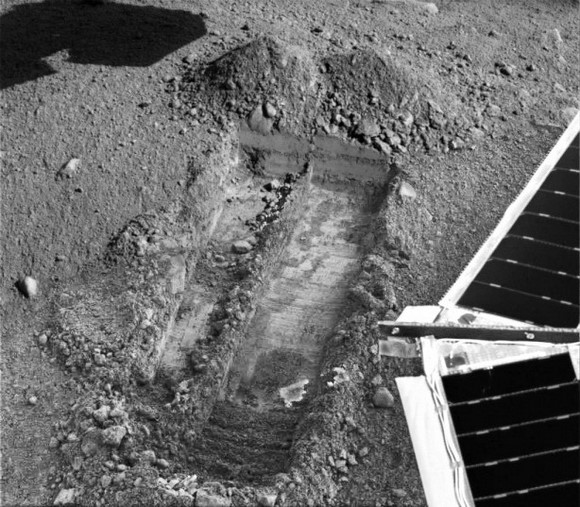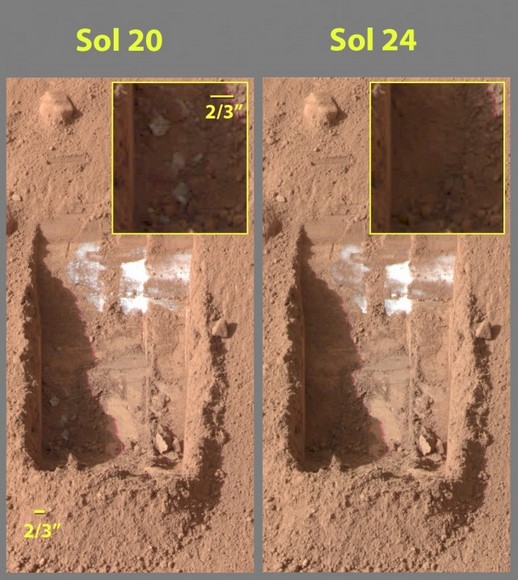Phoenix’s scientific team team held a press conference today to officially make their big announcement, which was fairly evident from pictures on the Phoenix website late yesterday: They found what they have been looking for. “It is with great pride and lot of joy that announce today we have found the proof that we have been seeking that show that this hard, white material is water ice,” said the project’s principle investigator Peter Smith. The image here shows a trench dug by Phoenix’s robotic arm scoop that exposed a white area, and left a couple of small chunks of white material, which scientists thought could possibly be ice. A few days later, the ice is gone. “In the course of sitting through the cold and very dry Martian environment for several days, it sublimated,” said Mark Lemmon, co-investigator on the Phoenix’s Surface Stero Imager. “The ice went away into vapor without any melting taking place.” But how do the scientists know for sure this is water ice?
“We can easily and confidently rule out that its carbon dioxide ice,” said Lemmon. “There are certainly times of the year that there would be CO2 ice at this location but with the temperatures we are measuring there, it would be the equivalent of water ice existing on Earth at 140 degrees. It wouldn’t be there very long, and wouldn’t be there long enough for us to take its picture, and it wouldn’t last the night. We’re very confident this is not CO2 ice. We’re ruling out salt, because salt doesn’t react like this. We’re confident now that this is water ice. We’ve hit what we’re looking for. The job now is to find out what is mixed in with the ice, how much salt is there, how many organics are there, and these are the things we’ll need TEGA and MECA to solve.”
TEGA is the Thermal and Evolved Gas Analyzer that “bakes and sniffs” out the chemical composition of the soil, and MECA is Microscopy, Electrochemistry and Conductivity Analyzer, a wet chemistry lab that measures levels of acidity, minerals, and conductivity in dirt samples.
Smith said the landing site was carefully chosen as a place where ice was very likely to exist, based on subsurface hydrogen detected by the orbiting 2001 Mars Odyssey spacecraft.
The team is now going to look for two things associated with the ice. “Does the ice melt, and does the melted ice environment allow a habitable zone on Mars,” said Smith. “That is a place where organic material and energy sources combined with liquid water can be a habitat for Martian life. We don’t have instruments that detect life itself. We’re looking at this stage for habitability, and it will be future missions that will look for life.”
The trick now is to get some of this white material into the TEGA instrument ovens before it sublimates. “The plan for sampling the ice is to gather it up rather quickly using the power tool called the Rasp and deliver it to the TEGA within 30 minutes,” said Ray Arvidson of the Phoenix team. The TEGA ovens do have airtight seal so it’s possible that the ice could go to a liquid stage while being heated. However, because of Mars low surface pressure, the boiling point of water on Mars is 4 Celsius.
Now that they know the ice is there, the scientists want to know more about the soil and why it seems to have a sticky, clumpy consistency. “Knowing that this is ice here, it allows you to speculate there are certain salts that mixed with ice can melt at low temperatures” said Smith. It’s very tempting to get a sample of this into MECA as soon as we can. Right now we have some speculations but no real interpretations available yet. I truly believe we will have answers for you by the end of the summer and hopefully earlier, so stick with us.”

The robotic arm is now digging in a new area in the trench called Snow White. They’ve dug a double trench and have hit a hard layer of ice. The team will try other techniques to see how hard the ice is, and how deep it goes, and try to dig down deeper. They will take their time, however, to make sure the sequences they use for the scraper and rasper work correctly (so as not to repeat having delays similar to what happened the first time they tried getting the soil into TEGA.)
Project manager Barry Goldman also said that the problem with Phoenix’s memory is understood, and two software patches being created to solve the problem of that used up all the space on Phoenix’s version of a flash drive.
Source: Phoenix Press Conference


They just discover the Mediterranean! As if they didn’t know. Water was detected in Europe, and they needed a probe with a lab landing on Mars to do the same.
I hold off any preconceived notions until they test it , so until then , I’ll just say I hope this means they’ll eventually send a nuke to level off and reshape Mars’ atmosphere then send another one to melt all the ice so Mars can have oceans , because we all know oceans are the pristine source of drinking water…..and that’s how the aliens will wanna go back there
Hmm! Why can’t this “evaporated” water be detected in what there is of the Mars atmosphere?
Wahooo! Start popping the champain corks NASA (but don’t get any on the telemetry controls though)!
Just clicked in here after checking out news and seeing this all over the place. I’m sure there will be a lot of good and bad gab here, as usual, but must at least add my own “Hoorah” to the line. One other good comment, the photo here is better than others I saw, and even with a good zoom, it held quality. I see many spots I would personally consider very likely signs of the sublimination of the ice,. even in the base of the trench. More study of other photos may confirm a good number of ice clumps not mentioned in news articles. I, for one, will certainly keep studying these, and may even click into NASA to see if I can get a few more of the series they took here!
so,in the base of the trench a white clump has been exposed and its no longer there.
couldnt it be that un upward spiralling of dust such as a willy-willy which are common on mars has covered the white clump?
Why not white clay or marble like stone ?
Sorry if I missed the explanation of what difference is between the inset & the main picture. If I haven’t, why don’t folks clearly explain the difference between the two?
Just clicked in here after checking out news and seeing this all over the place. I’m sure there will be a lot of good and bad gab here, as usual, but must at least add my own “Hoorah” to the line. One other good comment, the photo here is better than others I saw, and even with a good zoom, it held quality. I see many spots I would personally consider very likely signs of the sublimination of the ice,. even in the base of the trench. More study of other photos may confirm a good number of ice clumps not mentioned in news articles. I, for one, will certainly keep studying these, and may even click into NASA to see if I can get a few more of the series they took here! I totally agree with Koostar’s interpretation of this new development. NASA’s mantra of ‘follow the water’ has almost certainly been fulfilled. Now the task of analyzing impurities in the ice can commence. Bravo Phoenix.
Damo-
The inset is a close-up of the ice nuggets that are visible in the image from Sol 20 but have disappeared by Sol 24
…. ‘pretty confident’ is not ‘proof’. I am going to remain skeptical until they do the oven tests.
It’s pretty odd that he said “proof” (it’s strong, powerful evidence but it’s still not proof!)
That said I am for one convinced. Now please test some of it!
This potential water ice can be been in the twin rovers tracks. Couldn’t NASA return to one of the tracks they photographed and see if the white material has sublimated there as well?
For those more familiar with metric than imperial two-thirds of an inch (2/3″) works out to be 17 mm. Both seem to be very unusual numbers to choose for a scale. Maybe NASA is using the “Martian Metre” to go along with the “Sol”.
(The metre on Earth was originally defined as one-ten millionth of the distance from the north pole to the equator through Paris, France. So using the same definition on Mars the metre would be about 53.3 cm long thus the scale on the photo would be 32 martian millimetres)
This is really Cool stuff!! I can’t wait until they confirm it!!!
I am a little disturbed by the fact that so many “trivial” things are bugging this particular adventure on the planet. They’ve had 32 years to work out the wrinkles from the Viking landers and it seems they are having similar problems in the same areas like –
RETRIEVING the SAMPLES!!!!
But Good Job NASA!!
Can they make Ice Cream out of Martian water Ice?